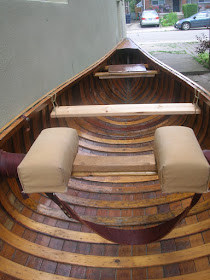It worked perfectly fine as a kneeling seat but turned out to be quite cumbersome when attempting to pole. Basically the presence of the sling required extra delicate foot work to avoid tripping when getting into a traditional poling position. Unbuckling the leather straps to remove the seat and then trying to re-attach them while in the boat proved too challenging. So another solution was in order.
The inspiration for the solution came from a Finnish design company that makes wooden children's tree swings. A carved seat with strategically placed slots for the rope to weave through
Plank seats are nothing new in canoeing history - they were often used on large trade canoes when the crew wasn't sitting on the cargo directly. Anyway, before attempting to make anything too labour intensive, I set out to make a basic plank seat with some scraps. In this case, discarded twin bed slats left behind by a neighbour on garbage day. These 1x4 pine slats were in great condition and I've since used them in plenty of non-canoe related projects around the house.
Discarded IKEA bed slats
Anyway, some holes were drilled and notches easily cut out in the plank. Then some remnant paracord was tied together in a double fisherman's knot and looped through the inwales. There's enough slack in the cordage to wrap around a third time in order to elevate the overall height, but this is how the plank seat is setup for now.
The seat does wiggle a bit from side to side and front to back because it wasn't perfectly shaped to fit the contours of the hull at this point in the experiment. It might get shaped better at a later date. What does work nicely though is that it can be unhooked easily on one side and then positioned on the centre thwart out of the way for clearing some leg room.








No comments:
Post a Comment